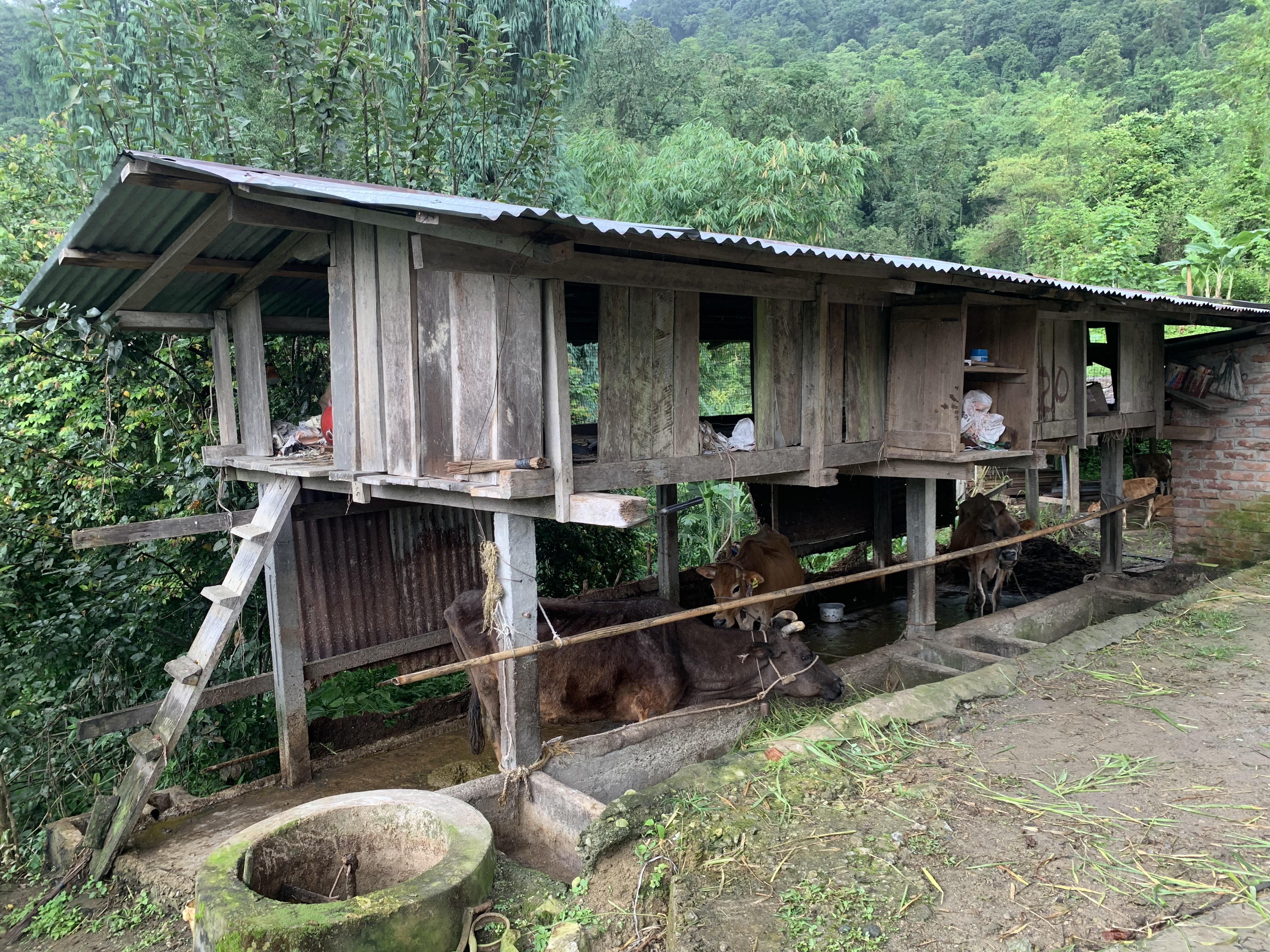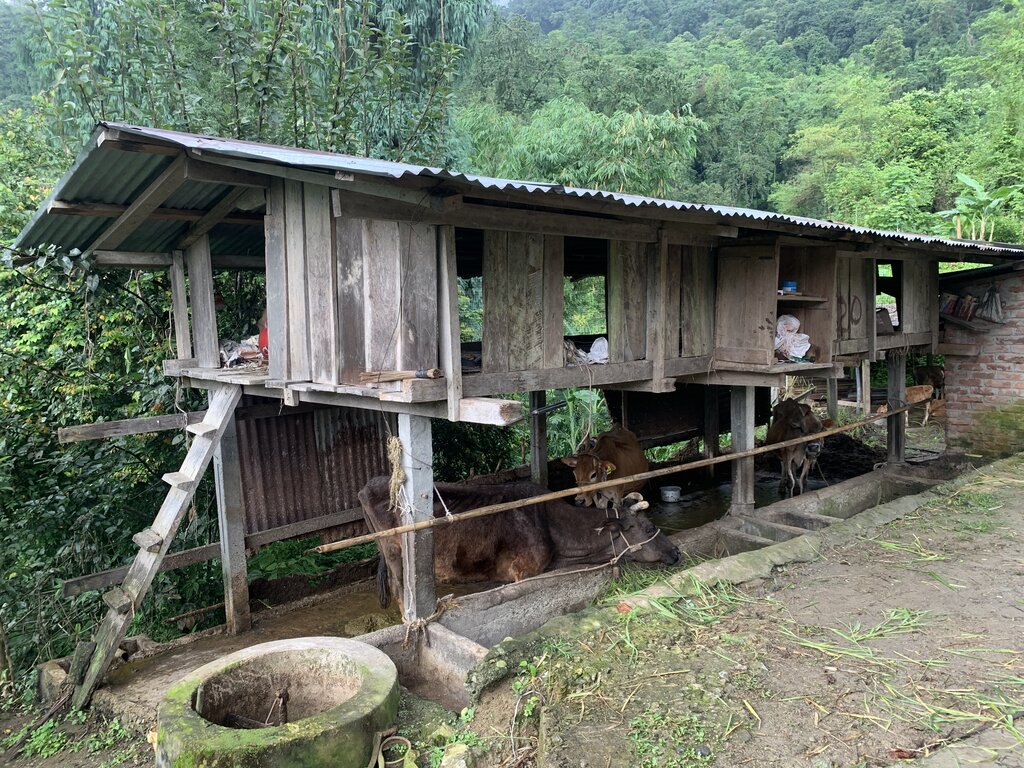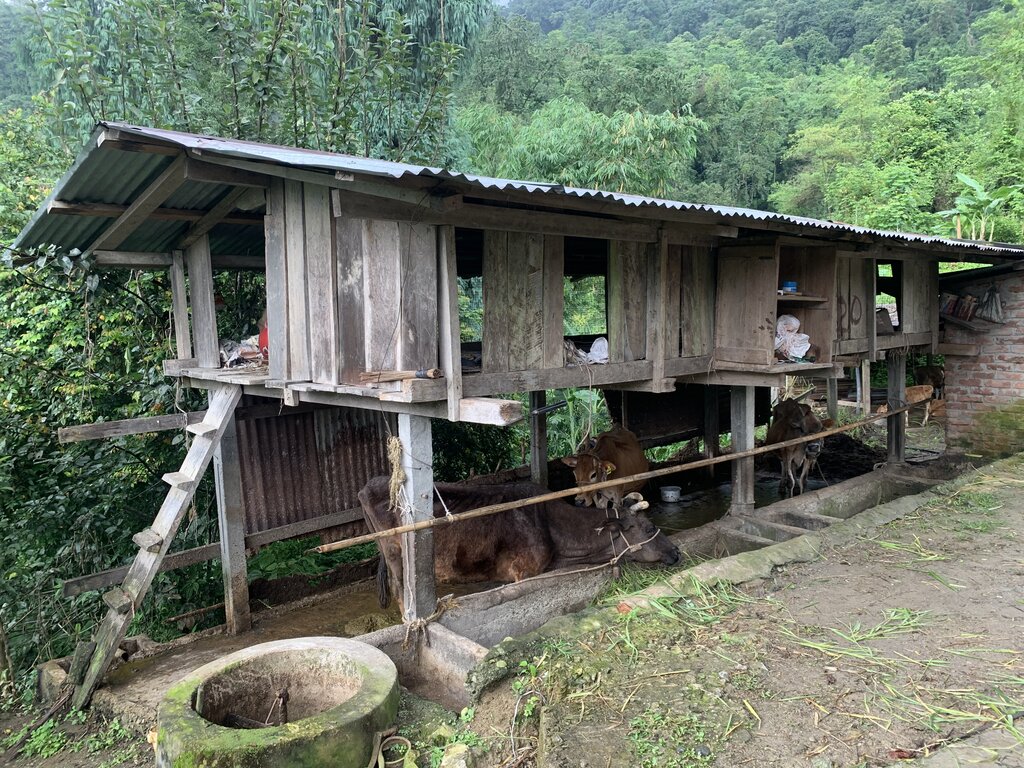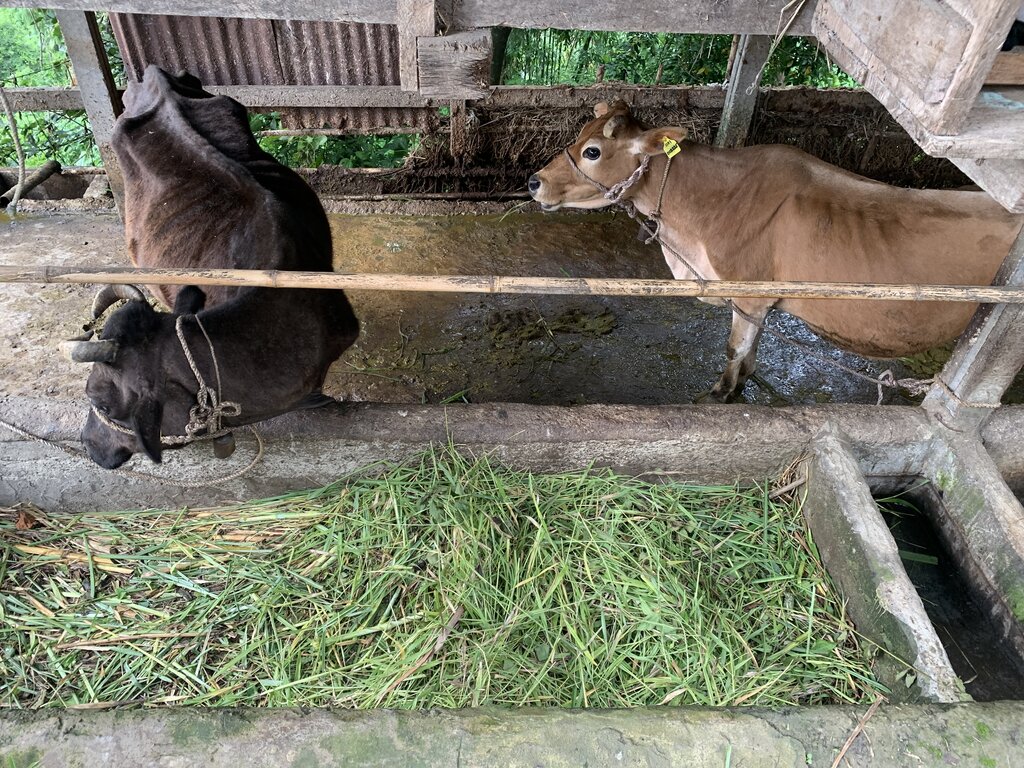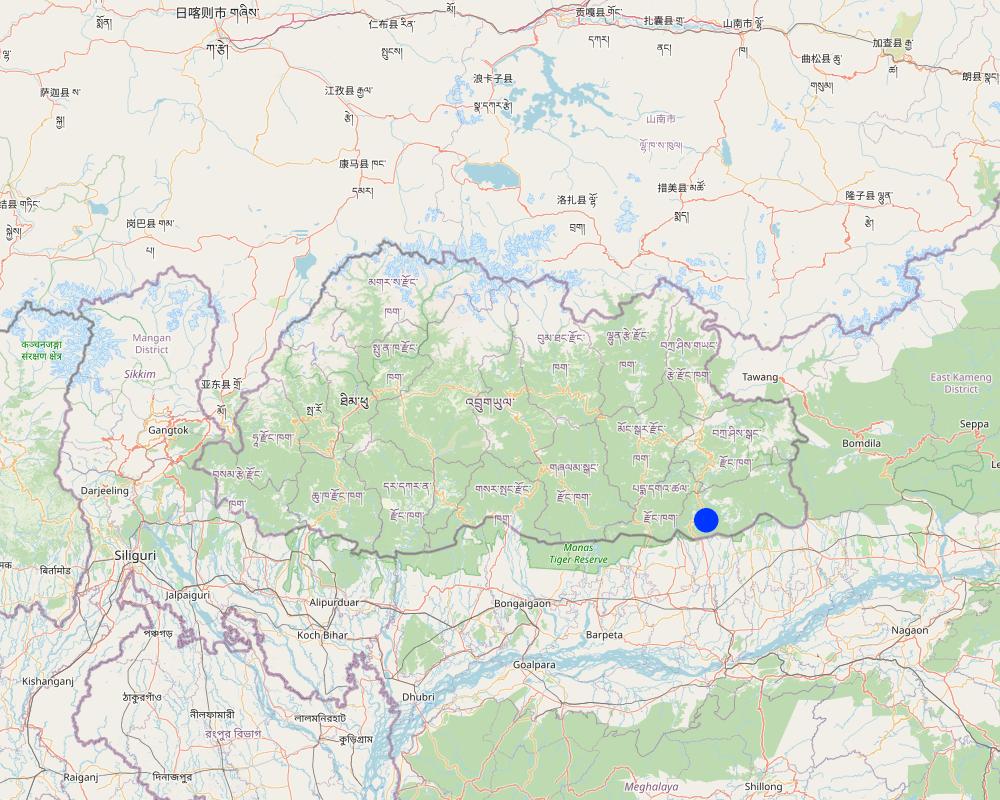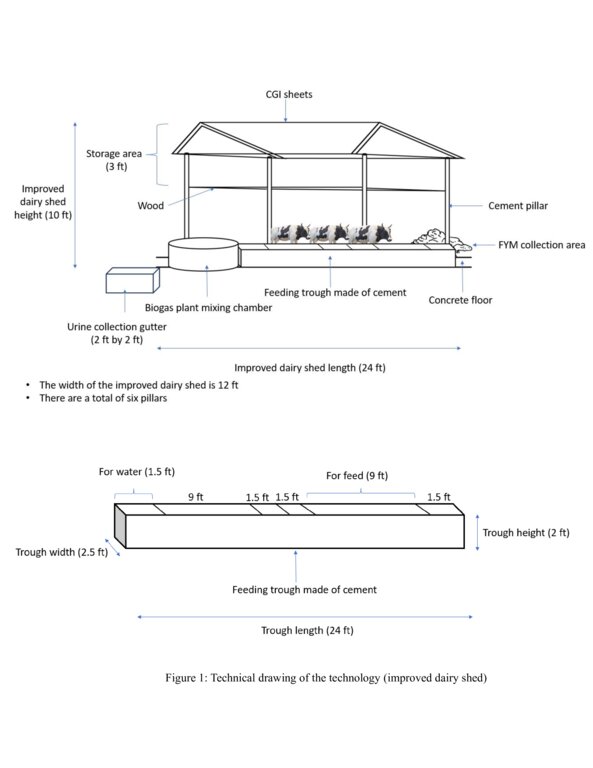Improved Dairy Shed [Bhutan]
- Creation:
- Update:
- Compiler: Tshering Yangzom
- Editor: Haka Drukpa
- Reviewers: William Critchley, Rima Mekdaschi Studer
technologies_6898 - Bhutan
View sections
Expand all Collapse all1. General information
1.2 Contact details of resource persons and institutions involved in the assessment and documentation of the Technology
Key resource person(s)
land user:
Zangpo Shacha
Bhutan
Name of project which facilitated the documentation/ evaluation of the Technology (if relevant)
Sustainable Land Management Project, Bhutan (SLMP)Name of the institution(s) which facilitated the documentation/ evaluation of the Technology (if relevant)
National Soil Services Center, Department of Agric (National Soil Services Center, Department of Agric) - Bhutan1.3 Conditions regarding the use of data documented through WOCAT
The compiler and key resource person(s) accept the conditions regarding the use of data documented through WOCAT:
Ja
1.4 Declaration on sustainability of the described Technology
Is the Technology described here problematic with regard to land degradation, so that it cannot be declared a sustainable land management technology?
Nee
1.5 Reference to Questionnaire(s) on SLM Approaches (documented using WOCAT)
2. Description of the SLM Technology
2.1 Short description of the Technology
Definition of the Technology:
An improved dairy shed in Bhutan is characterized by concrete floors, cement pillars and troughs, enough sunlight and ventilation, adequate water, ample space for cattle movement, as well as urine and dung collection gutters and a farmyard manure collection area.
2.2 Detailed description of the Technology
Description:
The main characteristics of the improved dairy shed are concrete floors, cement pillars and troughs, enough sunlight and ventilation, adequate water, ample space for cattle movement, urine and dung collection gutters, and a farmyard manure (FYM) collection area. The main purposes are to (a) enhance the overall well-being of animals, (b) optimize animal production, (c) minimize forest grazing and promote stall feeding, (d) increase the availability of FYM and urine for application to croplands, (e) develop pasture with fodder grasses, and (f) provide a comfortable working environment for land users.
The main inputs needed for establishment are cement for concrete floors, pillars, and troughs, and corrugated galvanised iron (CGI) sheets for roofing. The principal activities needed to maintain the technology are undertaking stall feeding instead of forest grazing, developing improved pasture with fodder grasses and trees, replacing low-yielding local cows with improved breeds dairy breeds such as Jerseys through buying or breeding (naturally or through Artificial Insemination [AI]), and better waste management.
The benefits of the technology include (a) the addition of nutrients to fields through the application of FYM and cattle urine, (b) an associated increase in organic matter, (c) better soil moisture retention, (d) availability of good quality fodder and a diverse range of forage options, (e) reduced labour due to less wild fodder collection and herding in the forest, (f) efficient waste utilization, (f) the potential manufacture and use of renewable biogas instead of liquid petroleum gas (LPG), (g) reduced land degradation due to reduction in forest grazing, (h) increased vegetation cover due to improved pasture development, (i) less soil compaction through decreased trampling by animals, (j) more comfortable working environment for land users, (k) improved livestock health and animal welfare, and (l) improved livelihoods of farmers through higher farm income. Besides these benefits, land users like the durability of the new sheds. However, one of the constraints of the technology is that the land users may lack funds to construct the sheds, or for improved cattle breeds, to justify the extra investment. These can hopefully be overcome by government support to land users through cost-sharing measures.
2.3 Photos of the Technology
2.4 Videos of the Technology
Comments, short description:
Improved dairy shed (a)
https://www.youtube.com/watch?v=ciXnVkJEOZw
Improved dairy shed (b)
https://www.youtube.com/watch?v=-AySt7Bo9Os
Date:
10/07/2023
Location:
Martang village, Dewathang gewog, Samdrup Jongkhar Dzongkhag
Name of videographer:
Tshering Yangzom
2.5 Country/ region/ locations where the Technology has been applied and which are covered by this assessment
Country:
Bhutan
Region/ State/ Province:
Martang village, Dewathang gewog, Samdrup Jongkhar Dzongkhag
Specify the spread of the Technology:
- applied at specific points/ concentrated on a small area
Is/are the technology site(s) located in a permanently protected area?
Nee
Map
×2.6 Date of implementation
Indicate year of implementation:
2014
2.7 Introduction of the Technology
Specify how the Technology was introduced:
- through land users' innovation
- through projects/ external interventions
Comments (type of project, etc.):
The land user adopted improved dairy shed partly at the suggestion of the livestock extension officer and partly due to his interest in improving his dairy shed.
3. Classification of the SLM Technology
3.1 Main purpose(s) of the Technology
- improve production
- reduce, prevent, restore land degradation
- create beneficial economic impact
3.2 Current land use type(s) where the Technology is applied
Land use mixed within the same land unit:
Ja
Specify mixed land use (crops/ grazing/ trees):
- Agro-silvopastoralism

Cropland
- Annual cropping
- Perennial (non-woody) cropping
- Tree and shrub cropping
Annual cropping - Specify crops:
- cereals - maize
- legumes and pulses - beans
- vegetables - leafy vegetables (salads, cabbage, spinach, other)
- Cole crops, root crops, Solanaceous crops, Mustard Green
Perennial (non-woody) cropping - Specify crops:
- fodder crops - grasses
Tree and shrub cropping - Specify crops:
- avocado
- citrus
- Mango, pomegranate, jackfruit
Specify:
Vegetables have one growing season. Maize is grown twice. Fodder grasses and fruit trees have many growing seasons.
Is intercropping practiced?
Ja
If yes, specify which crops are intercropped:
There is intercropping among vegetables and intercropping between vegetables and fruit trees.
Is crop rotation practiced?
Ja
If yes, specify:
Vegetables are grown in rotation.

Grazing land
Intensive grazing/ fodder production:
- Cut-and-carry/ zero grazing
- 7 cattle (Jersey crosses)
Is integrated crop-livestock management practiced?
Ja
If yes, specify:
The crop residues serve as feeds for animals and livestock wastes such as cow dung and urine are used as organic fertlizers for crops. These organic fertlizers enhance soil health and reduce the need for synthetic fertlizers.
Products and services:
- milk
Species:
cattle - dairy
Count:
7
3.3 Has land use changed due to the implementation of the Technology?
Has land use changed due to the implementation of the Technology?
- No (Continue with question 3.4)
3.4 Water supply
Water supply for the land on which the Technology is applied:
- mixed rainfed-irrigated
3.5 SLM group to which the Technology belongs
- pastoralism and grazing land management
- integrated crop-livestock management
- integrated soil fertility management
3.6 SLM measures comprising the Technology

structural measures
- S9: Shelters for plants and animals
3.7 Main types of land degradation addressed by the Technology

chemical soil deterioration
- Cn: fertility decline and reduced organic matter content (not caused by erosion)
3.8 Prevention, reduction, or restoration of land degradation
Specify the goal of the Technology with regard to land degradation:
- prevent land degradation
- reduce land degradation
Comments:
Application of FYM to the field results in an increase in organic matter and an increase in nutrient availability in fields. There is better soil water retention by an increase in soil organic matter. Cattle urine also adds nutrients to the soil. Stall feeding under an improved dairy shed promotes the cultivation of fodder of good quality and variety. This helps maintain vegetative cover and prevent degradation of arable land. Similarly, stall feeding using crop residues from the field helps maintain vegetative cover and prevent the degradation of arable land. The land user feeds fodder grasses such as Super Napier and Napier that help stabilize soil and provide ground cover. Other feeds provided to cattle include banana stems, mustard cakes, straw, Guatemala grass, and processed feeds (Karma Feeds). The use of organic fertilizers such as cow dung and urine minimizes the need for chemical fertilisers that can cause loss of beneficial soil organisms, reduced organic matter, soil acidification, and nutrient imbalances in the soil.
4. Technical specifications, implementation activities, inputs, and costs
4.1 Technical drawing of the Technology
4.2 General information regarding the calculation of inputs and costs
Specify how costs and inputs were calculated:
- per Technology unit
other/ national currency (specify):
Nu
If relevant, indicate exchange rate from USD to local currency (e.g. 1 USD = 79.9 Brazilian Real): 1 USD =:
82.0
Indicate average wage cost of hired labour per day:
500
4.3 Establishment activities
| Activity | Timing (season) | |
|---|---|---|
| 1. | Deconstruction of old dairy shed that was made of wood and lacked cemented floor and pillars. | 2013 |
| 2. | Collection of raw materials to construct an improved dairy shed such as sand, stones, cement, and CGI sheets for roofing. | 2013 |
| 3. | Construction of the improved dairy shed (pillars, soling, roofing, storage area) | 2013-2014 |
Comments:
The construction of the improved dairy shed took months as the land user was engaged in other farm activities and only worked a few hours some days.
4.4 Costs and inputs needed for establishment
| Specify input | Unit | Quantity | Costs per Unit | Total costs per input | % of costs borne by land users | |
|---|---|---|---|---|---|---|
| Labour | manpower | person-days | 15.0 | 700.0 | 10500.0 | |
| Construction material | CGI sheet (8", 0.05mm) | No | 31.0 | 900.0 | 27900.0 | |
| Construction material | Boulder | Truck load | 1.0 | 7000.0 | 7000.0 | |
| Construction material | Gravel | Truck load | 0.5 | 17000.0 | 8500.0 | |
| Construction material | Sand | Truck load | 0.5 | 22000.0 | 11000.0 | |
| Construction material | Cement | Bag | 25.0 | 400.0 | 10000.0 | |
| Construction material | Planks | Cft | 150.0 | 350.0 | 52500.0 | |
| Construction material | Iron road | Kg | 150.0 | 75.0 | 11250.0 | |
| Total costs for establishment of the Technology | 138650.0 | |||||
| Total costs for establishment of the Technology in USD | 1690.85 | |||||
If you are unable to break down the costs in the table above, give an estimation of the total costs of establishing the Technology:
140000.0
If land user bore less than 100% of costs, indicate who covered the remaining costs:
Government
Comments:
The government provided 15 bags of cement and 18 CGI sheets.
4.5 Maintenance/ recurrent activities
Comments:
There has been no requirement of maintenance to date. There would not be the need of maintenance unless the technology is destroyed by natural disasters such as earthquake, storm, flood and so on. The technology is durable with concrete floors, pillars and troughs and corrugated galvanised iron (CGI) sheets for roofing.
4.6 Costs and inputs needed for maintenance/ recurrent activities (per year)
Comments:
There has been no requirement of maintenance to date.
4.7 Most important factors affecting the costs
Describe the most determinate factors affecting the costs:
Materials and transportation cost
5. Natural and human environment
5.1 Climate
Annual rainfall
- < 250 mm
- 251-500 mm
- 501-750 mm
- 751-1,000 mm
- 1,001-1,500 mm
- 1,501-2,000 mm
- 2,001-3,000 mm
- 3,001-4,000 mm
- > 4,000 mm
Specifications/ comments on rainfall:
1200-2500 mm
Indicate the name of the reference meteorological station considered:
The rain estimate has been derived based on the agro-ecological zone (AEZ) the area falls under. Bhutan is divided into six AEZs (source: https://www.fao.org/3/ad103e/AD103E02.htm).
Agro-climatic zone
- humid
Bhutan has six AEZs. The wet sub-tropical zone is from 150 to 600 m, followed by the humid sub-tropical zone from 600 to 1,200 m. The dry sub-tropical zone starts at 1,200 m and extends to 1,800 m, followed by the warm temperate zone, which reaches 2,600 m. The cool temperate zone lies between 2,600 and 3,600 m and, finally, the alpine zone between 3,600 m and 4,600 m.
5.3 Soils
Soil depth on average:
- very shallow (0-20 cm)
- shallow (21-50 cm)
- moderately deep (51-80 cm)
- deep (81-120 cm)
- very deep (> 120 cm)
Soil texture (topsoil):
- fine/ heavy (clay)
Soil texture (> 20 cm below surface):
- fine/ heavy (clay)
Topsoil organic matter:
- high (>3%)
If available, attach full soil description or specify the available information, e.g. soil type, soil PH/ acidity, Cation Exchange Capacity, nitrogen, salinity etc.
Moisture content-21.66%
Organic matter-15.14 %
Organic carbon-8.80%
pH-6.24
Electrical conductivity-521.33 µs/cm
Nitrogen-0.44
Phosphorus-2.42
Potassium-223.07 mg/100ml
Soil texture-Clay
5.4 Water availability and quality
Availability of surface water:
good
Water quality (untreated):
good drinking water
Water quality refers to:
surface water
Is water salinity a problem?
Nee
Is flooding of the area occurring?
Nee
5.5 Biodiversity
Species diversity:
- high
Habitat diversity:
- high
Comments and further specifications on biodiversity:
The site has a variety of crops including vegetables, fruit trees, trees, and fodder grasses.
5.6 Characteristics of land users applying the Technology
Sedentary or nomadic:
- Sedentary
Market orientation of production system:
- mixed (subsistence/ commercial)
Off-farm income:
- less than 10% of all income
Relative level of wealth:
- average
Individuals or groups:
- individual/ household
Level of mechanization:
- manual work
Gender:
- men
Age of land users:
- middle-aged
5.7 Average area of land used by land users applying the Technology
- < 0.5 ha
- 0.5-1 ha
- 1-2 ha
- 2-5 ha
- 5-15 ha
- 15-50 ha
- 50-100 ha
- 100-500 ha
- 500-1,000 ha
- 1,000-10,000 ha
- > 10,000 ha
Is this considered small-, medium- or large-scale (referring to local context)?
- large-scale
Comments:
The total land area owned by the owner is 4.65 acres (1.88 ha) which is large-scale. The average land holding at the national level is 3 acres (1.2 ha)
In the local context:
3 acres (1.2 ha) = medium scale
> 3 acres = large-scale
<3 acres = small-scale
5.8 Land ownership, land use rights, and water use rights
Land ownership:
- individual, not titled
Land use rights:
- individual
Water use rights:
- communal (organized)
Are land use rights based on a traditional legal system?
Ja
5.9 Access to services and infrastructure
health:
- poor
- moderate
- good
education:
- poor
- moderate
- good
technical assistance:
- poor
- moderate
- good
employment (e.g. off-farm):
- poor
- moderate
- good
markets:
- poor
- moderate
- good
energy:
- poor
- moderate
- good
roads and transport:
- poor
- moderate
- good
drinking water and sanitation:
- poor
- moderate
- good
financial services:
- poor
- moderate
- good
6. Impacts and concluding statements
6.1 On-site impacts the Technology has shown
Socio-economic impacts
Production
crop production
Comments/ specify:
Crop production has increased due to the use of FYM and urine from improved cattle shed.
crop quality
Comments/ specify:
Crop quality has increased due to the use of FYM and urine from improved cattle sheds. These organic fertilizers add nutrients to the soil and enhance crop growth and development.
fodder production
Comments/ specify:
Fodder plantation has been encouraged due to stall feeding under the improved dairy shed technology. The land user has planted fodder grasses on 1.2 acres of land. The fodder grasses grown include Napier, Super Napier, Guatemala grasses.
fodder quality
Comments/ specify:
The land user has planted fodder grasses (a mix of Super Napier, Napier, and Guatemala) on 1.2 acres of land to be fed to cattle. A variety of fodder grasses are grown for stall feeding of cattle.
animal production
Comments/ specify:
Animal production has increased due to improved fodder production and quality. The technology promotes integrated crop-livestock farming whereby the crop residues are fed to the cattle as feeds, another source of nutrients for the animals. Under the improved dairy shed, the animals have access to proper sunlight and ventilation, adequate water, and ample space for their movement resulting in the overall well-being of the animals.
product diversity
Comments/ specify:
Milk production has increased due to improved fodder production and quality grown for stall feeding. The milk provides raw material to produce a wide variety of dairy products.
production area
Comments/ specify:
Production area has increased with the land user growing fodder grasses in 1.2 acres of land. The land user feeds 7 dairy cattle with these fodder grasses.
energy generation
Comments/ specify:
The dung from shed is used in biogas plant to produce biogas. Biogas has reduced the use of LPG gas.
Income and costs
farm income
Comments/ specify:
Farm income has increased due to integrated livestock farming that has been promoted by improved dairy shed. Crop production and quality have improved due to the use of FYM and cattle urine. The increased milk production from stall feeding of good quality fodder grasses has enabled the land user to become a member of a milk group where the land user earns some amount every month.
diversity of income sources
Comments/ specify:
The land user is now a member of a milk group. The increase in milk has encouraged the land user to join the group.
Socio-cultural impacts
food security/ self-sufficiency
Comments/ specify:
Food security and self-sufficiency have increased due to increased animal production and crop production.
recreational opportunities
Comments/ specify:
Stall feeding has provided an opportunity for the land user to engage in recreational activities. Earlier when there was no stall feeding, the land user had to take cattle to a nearby forest and tend them for hours.
SLM/ land degradation knowledge
Comments/ specify:
The land user realizes the benefits of FYM application, stall feeding, fodder production, and biogas plant usage.
conflict mitigation
Comments/ specify:
When stall feeding was not practised, land user had issues with his cattle entering into neighbours' fields and damaging their fields. This problem has been mitigated by the practice of stall feeding.
situation of socially and economically disadvantaged groups
Comments/ specify:
The situation of socially and economically disadvantaged groups has improved due to increased farm production.
Ecological impacts
Soil
soil cover
Comments/ specify:
Soil cover has increased due to fodder grass cultivation on 1.2 acres of land.
nutrient cycling/ recharge
Comments/ specify:
Nutrient cycling has increased due to integrated livestock farming.
soil organic matter/ below ground C
Comments/ specify:
Soil organic matter has increased due to the addition of FYM to fields.
Biodiversity: vegetation, animals
Vegetation cover
Comments/ specify:
Vegetation cover has increased due to fodder grass plantation on 1.2 acres of land.
Climate and disaster risk reduction
emission of carbon and greenhouse gases
Comments/ specify:
Biogas plant has reduced the use of LPG gas and methane emissions.
6.2 Off-site impacts the Technology has shown
Specify assessment of off-site impacts (measurements):
There hasn't been notable off-site impacts.
6.3 Exposure and sensitivity of the Technology to gradual climate change and climate-related extremes/ disasters (as perceived by land users)
Gradual climate change
Gradual climate change
| Season | increase or decrease | How does the Technology cope with it? | |
|---|---|---|---|
| annual temperature | increase | very well | |
| seasonal temperature | summer | increase | very well |
| annual rainfall | increase | very well | |
| seasonal rainfall | summer | increase | well |
6.4 Cost-benefit analysis
How do the benefits compare with the establishment costs (from land users’ perspective)?
Short-term returns:
positive
Long-term returns:
very positive
How do the benefits compare with the maintenance/ recurrent costs (from land users' perspective)?
Short-term returns:
positive
Long-term returns:
very positive
6.5 Adoption of the Technology
- > 50%
If available, quantify (no. of households and/ or area covered):
25 households out of 28 households have adopted the technology
Of all those who have adopted the Technology, how many did so spontaneously, i.e. without receiving any material incentives/ payments?
- 0-10%
6.6 Adaptation
Has the Technology been modified recently to adapt to changing conditions?
Nee
6.7 Strengths/ advantages/ opportunities of the Technology
| Strengths/ advantages/ opportunities in the land user’s view |
|---|
| An improved dairy shed made of cement, gravel, and stones is more durable than the old dairy shed made from wood. |
| Addition of nutrients in fields through application of FYM and cattle urine. |
| Increase in organic matter due to FYM application in the field. |
| Availability of good quality fodder and a diverse range of forage options. |
| Reduced labour due to reduced fodder collection and herding in the forest. |
| Strengths/ advantages/ opportunities in the compiler’s or other key resource person’s view |
|---|
| Efficient waste utilization. |
| Biogas has reduced the use of LPG gas. |
| Reduced land degradation due to reduction in forest grazing |
| Increased vegetation cover due to improved pasture development and reduction in forest grazing. |
| Stall feeding reduces soil compaction through trampling by animals. |
| Better soil moisture retention by increased soil organic matter. |
| Comfortable working environment for land users. |
| Improved livelihood of farmers through higher farm yields and better household income. |
6.8 Weaknesses/ disadvantages/ risks of the Technology and ways of overcoming them
| Weaknesses/ disadvantages/ risks in the land user’s view | How can they be overcome? |
|---|---|
| The land user has designed the slurry inlet chamber of the biodigester plant near feeding troughs so the inlet chamber has to be relocated. | Relocate the biodigester. |
| Lack of funds to buy improved breeds. | Government support to land users through cost-sharing measures. |
| Lack of funds for improved dairy shed construction. | Government support to land users through cost-sharing measures. |
7. References and links
7.1 Methods/ sources of information
- field visits, field surveys
1
- interviews with land users
1
When were the data compiled (in the field)?
10/07/2023
7.2 References to available publications
Title, author, year, ISBN:
Thapa, L., Choden, D., & Tamang, N. B. (2019). Adoption of Improved Dairy Production Practices by Dairy and Non- Dairy Farmers’ Groups.
Available from where? Costs?
https://www.researchgate.net/profile/Lokey-Thapa/publication/334507972_Adoption_of_Improved_Dairy_Production_Practices_by_Dairy_and_Non-_Dairy_Farmers'_Groups/links/5d2ec146299bf1547cbd248a/Adoption-of-Improved-Dairy-Production-Practices-by-Dairy-and-Non-Dairy-Farmers-Groups.pdf
7.3 Links to relevant online information
Title/ description:
National Soil Services Centre. (2011). Bhutan Catalogue of Soil and Water Conservation Approaches and Technologies. National Soil Services Centre, Department of Agriculture, Ministry of Agriculture and Forests, Royal Government of Bhutan, Thimphu.
URL:
https://www.wocat.net/library/media/95/
7.4 General comments
There is a need to increase number of respondents to get realistic data.
Links and modules
Expand all Collapse allLinks
No links
Modules
No modules


